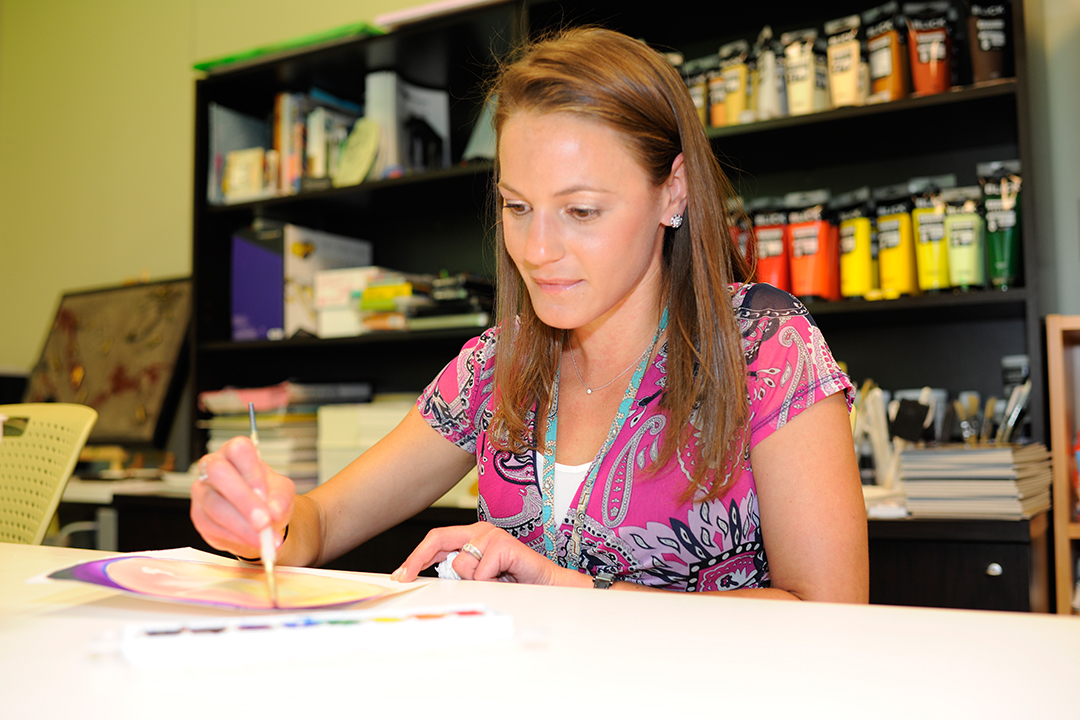By John DiConsiglio
The soldier fidgeted nervously. This was the last place he wanted to be. He could have been back home with his family in Kentucky. Or even back in Afghanistan with his infantry unit. Anywhere but here—a makeshift art room in the Fort Belvoir, VA, hospital, surrounded by jars of paint, wooden brushes and colored pencils. Jittery and uncomfortable, he shook his head and sighed, thinking there was no way this was going to work.
Jackie Biggs, MA ’13, has seen this reaction before. As an art therapist at Fort Belvoir Community Hospital’s National Intrepid Center of Excellence, her clients are often combat veterans returning from harrowing tours of duty in Afghanistan and Iraq. Some suffer from brain injuries and psychological conditions like post-traumatic stress disorder. They struggle with issues of loss, grief and transitioning to life back home. And after years of risking their lives in a war zone where they could trust only their buddies, they usually have little faith that Biggs’s canvases and brushes are going to make them whole again.
“Most walk in here hesitant and kind of weirded out,” Biggs said. “They haven’t created art since they were five. They’ve just returned from combat. When they pick up a brush, there’s an awful lot of skepticism.”
In many ways, Biggs has spearheaded the hospital’s art-therapy-for-soldiers initiative. After graduating from Columbian College’s rigorous Art Therapy Program, she approached the National Endowment for the Arts with a grant proposal to integrate art therapy into treatment for active-duty military patients at Fort Belvoir. After a three-month pilot project, the treatment has become a standard component of patient/soldier protocol at the hospital. Alongside neurologists, physical therapists and other healthcare providers, Biggs uses tools like visual arts and mask-making to help combat veterans process traumatic events.
“This is a group that tends to internalize their trauma; they hope it will go away if they just don’t talk about it,” she noted. More often, she said the results are tragic: depression, isolation, substance abuse and even suicide. “We can intervene in that cycle. Art therapy can give them a voice when the words aren’t there.”
Earning Respect
While a widely respected academic discipline, art therapy still faces challenges winning acceptance in the health care world. Only seven states currently license art therapists. In many cases, graduates with art therapy degrees end up applying their skills to counseling or teaching positions. “We still have to constantly prove that what we do has value,” Biggs said.
Biggs said GW’s Art Therapy Program, one of the first in the country, prepared her to thrive in a challenging environment through its unique “trauma track.” The intensive focus on people who have suffered traumatic incidents—from car accidents to violence to the loss of loved ones—includes hands-on experience counseling clients at the program’s clinic.
“Art therapy helps you access painful memories in a nonthreatening way,” said Heidi Bardot, director of the program. “The brain stores traumatic images in a visual context. Through artwork, you can examine and process those disturbing images at a safe distance.”
Biggs pursued an art therapy degree in the hope that her professional path would guide her toward working with women and children. After her first year, she joined Bardot on a summer-abroad program in India, providing art therapy services to homeless women. Biggs’s second-year project on combating bullying through art won her the program’s prestigious Kwiatkowska Award, given annually to students with exceptional strengths in family assessment or group research.
Like all GW art therapy students, Biggs was required to work with a range of clients. Students must participate in internships in both community-based and clinical settings, and work with youth and adults. “Many of our students come here with their minds made up that they are only going to work with, say, adolescents,” Bardot noted. “We encourage them to keep their options open. It may dawn on them that what they really love is communicating with the elderly.”
Biggs had little experience with combat veterans before joining Fort Belvoir’s team, but she relished the challenge of helping soldiers connect with their feelings through art. She eases client skepticism by stressing that the focus is not on skilled artistry or a polished product. “I’m not here to critique work,” she said. “I guide my clients, but it’s ultimately up to them to choose a direction. I help them make sense of what they’ve created.”
Sitting across from the reluctant Kentucky soldier at her Fort Belvoir art table, Biggs encouraged him to relax and be spontaneous. “Grab a palate knife and a color you’re drawn to,” she calmly instructed. “Don’t think, just do what feels right.”
The soldier used his tools to apply seemingly random splotches of red and blue paint across a canvas. The end product was stunning to both him and Biggs: The soldier recreated what he had seen through his sniper rifle’s scope just before he first killed someone.
“It was amazing,” said Biggs. “He was expressing the anger and regrets he’d been holding inside. That’s the thing about art therapy. Your subconscious gets going and reveals what’s going on inside your head.”


